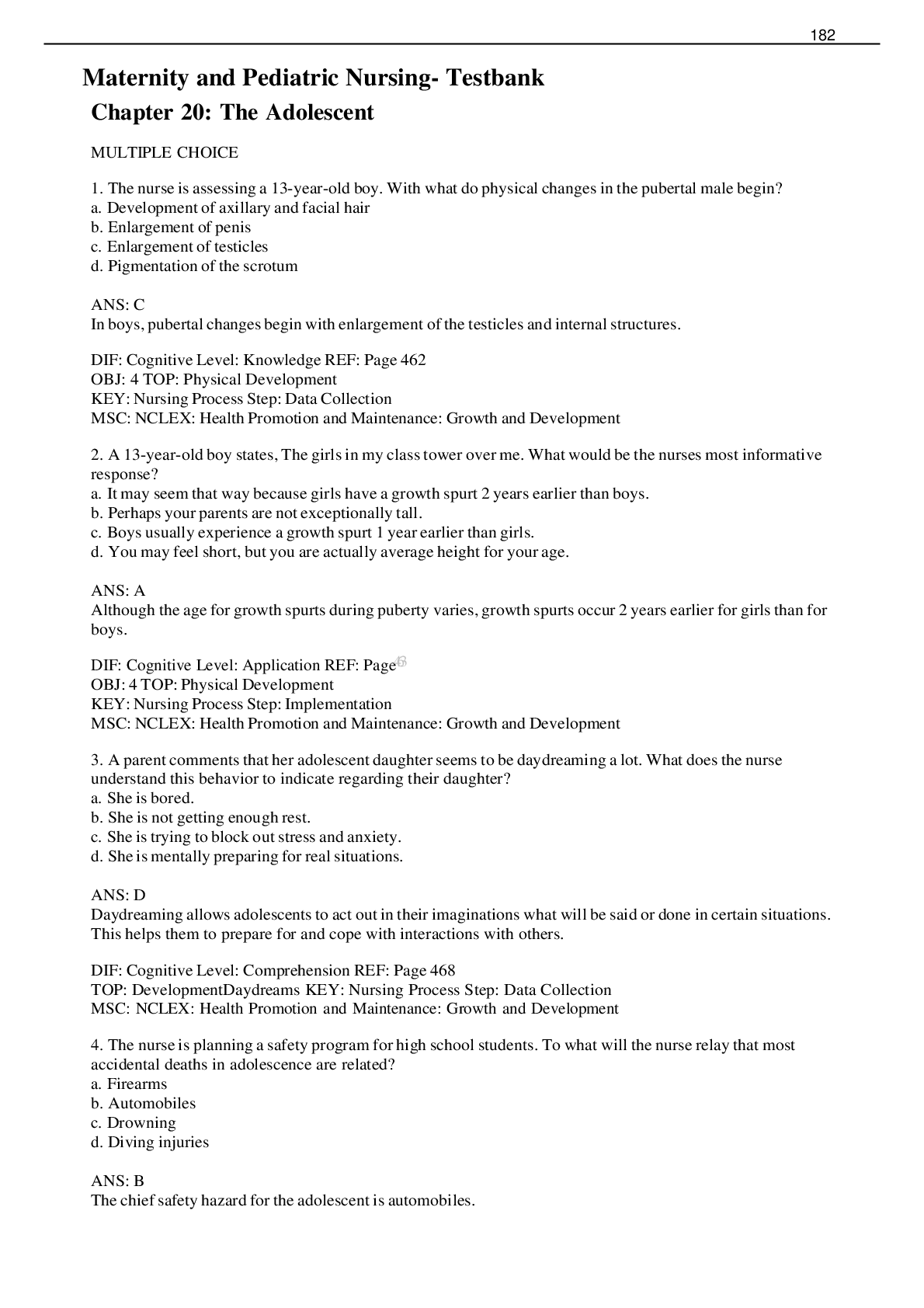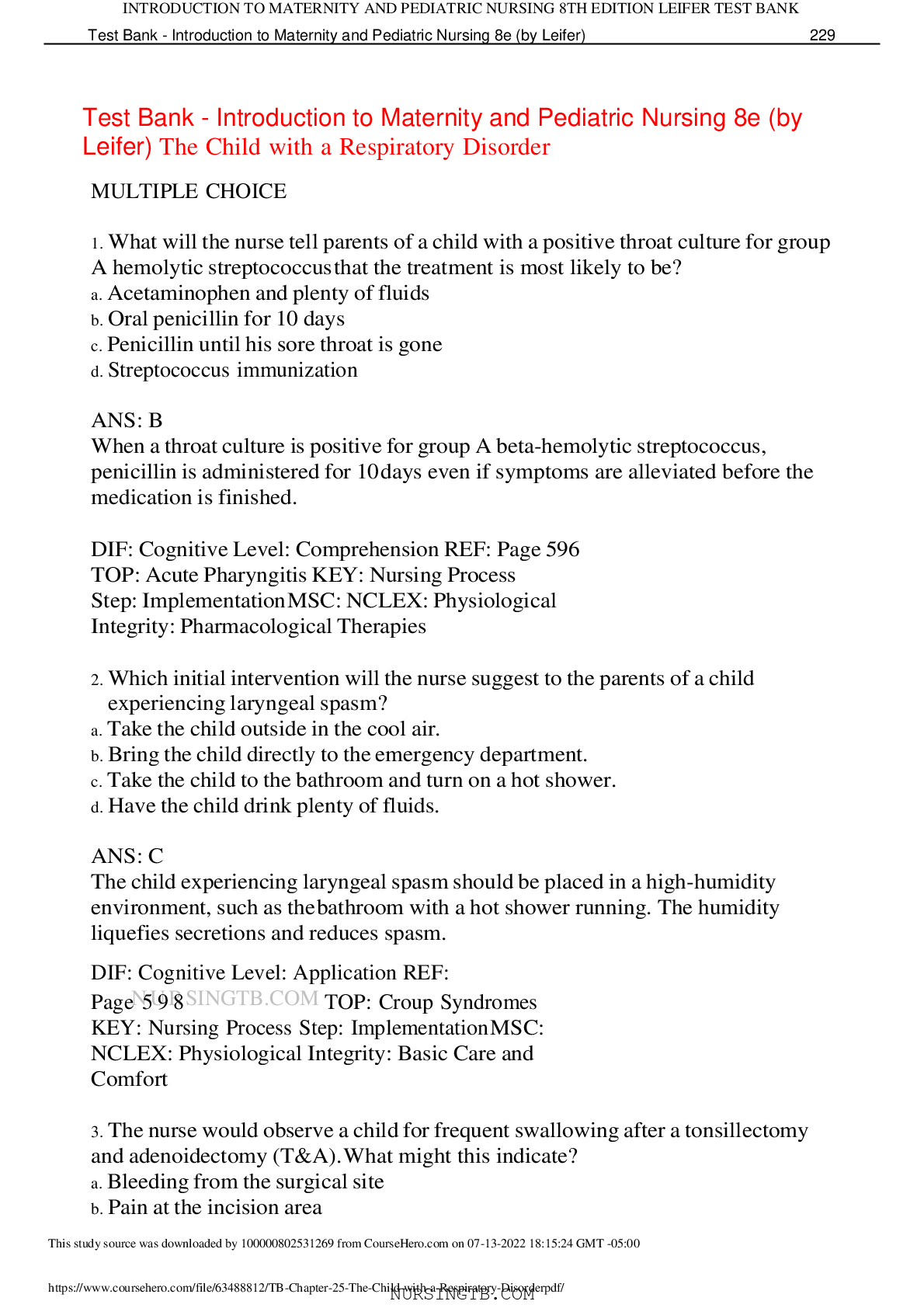INTRODUCTION TO MATERNITY AND PEDIATRIC NURSING TOP GRADE
Document Content and Description Below
INTRODUCTION TO MATERNITY AND PEDIATRIC NURSING Chapter 15: An Overview of Growth, Development, and Nutrition MULTIPLE CHOICE 1. What type of development is the nurse assessing when an infant c... an lift his or her head before he or she can sit? a. Specific to general b. Proximodistal c. Cephalocaudal d. General to specific ANS: C Cephalocaudal development proceeds from head to toe. DIF: Cognitive Level: Comprehension REF: Page 353, Figure 15-1 OBJ: 1 TOP: Cephalocaudal Development KEY: Nursing Process Step: Data Collection MSC: NCLEX: Health Promotion and Maintenance: Growth and Development 2. What is a unique organization of characteristics that determines an individual’s pattern of behavior? a. Environment b. Heredity c. Personality d. Experience ANS: C One definition of personality states that it is a unique organization of characteristics that determines the individual’s typical or recurrent pattern of behavior. DIF: Cognitive Level: Knowledge REF: Page 360 OBJ: 1 TOP: Personality Development KEY: Nursing Process Step: N/A MSC: NCLEX: Health Promotion and Maintenance: Growth and Development 3. An infant’s birth weight is 7 pounds, 8 ounces. What can the nurse project the weight to be at 6 months? a. 12 pounds b. 15 pounds c. 18 pounds d. 22 pounds ANS: B An infant usually doubles his or her birth weight by 5 to 6 months. DIF: Cognitive Level: Analysis REF: Page 353, Figure 15-1 OBJ: 4 TOP: Weight Prediction KEY: Nursing Process Step: Data Collection MSC: NCLEX: Health Promotion and Maintenance: Growth and Development 4. What would the nurse further investigate when assessing patterns of growth in a child? a. Previous weight was in the 75th percentile, and present weight is in the 25th percentile. b. Height is in the 90th percentile, and weight is in the 75th percentile. c. Last weight was in the 5th percentile, and present weight is in the 10th percentile. d. Weight is in the 50th percentile, and sibling’s weight at the same age was in the 75th percentile. ANS: A The child showing a difference of two or more percentile levels from an established growth pattern should undergo further evaluation. DIF: Cognitive Level: Analysis REF: Page 356 OBJ: 4 TOP: Growth KEY: Nursing Process Step: Data Collection MSC: NCLEX: Health Promotion and Maintenance: Growth and Development 5. A mother reports that she and her husband have had one child together, but both have children from previous marriages living in their home. The nurse will base the care planning on what type of family? a. Nuclear b. Blended c. Alternate d. Extended ANS: B A blended family involves the remarriage of persons with children. DIF: Cognitive Level: Comprehension REF: Page 359, Table 15-1 OBJ: 6 | 7 TOP: The Family KEY: Nursing Process Step: Planning MSC: NCLEX: Psychosocial Integrity: Psychosocial Adaptation 6. The mother of a 7-month-old reports that the first lower central incisor has erupted. She asks the nurse, “How many teeth will he have by his first birthday?” The nurse explains that the infant will have how many teeth by 1 year of age? a. 2 b. 4 c. 6 d. 8 ANS: C The 1-year-old infant usually has about 6 teeth, 4 above and 2 below. DIF: Cognitive Level: Knowledge REF: Page 380 OBJ: 10 TOP: Dentition KEY: Nursing Process Step: Implementation MSC: NCLEX: Health Promotion and Maintenance: Growth and Development 7. At a well-baby visit, parents of a 6-month-old ask when to take the infant for the first dental visit. What is the nurse’s best response? a. “If the teeth are brushed regularly, the child should see a dentist by 3 years of age.” b. “The first dental visit should be arranged after the first tooth erupts.” c. “The child should have a dental examination when all deciduous teeth have erupted.” d. “A dental visit by 1 year of age is recommended by the American Academy of Pediatric Dentistry.” ANS: D The Academy of Pediatric Dentistry recommends that the first dental visit occur by 1 year of age. DIF: Cognitive Level: Application REF: Page 380 OBJ: 10 TOP: Dentition KEY: Nursing Process Step: Implementation MSC: NCLEX: Health Promotion and Maintenance: Prevention and Early Detection of Disease 8. The nurse is planning anticipatory guidance for a caregiver of a preschool-age child. The nurse will explain that permanent teeth begin erupting at what age? a. 4 years old b. 6 years old c. 8 years old d. 10 years old ANS: B Permanent teeth do not erupt through the gums until the sixth year. 9. A mother asks the nurse how much food should be offered to her 2-year-old. What is a good rule of thumb for serving size (in tablespoons) per year of age? a. 2 b. 3 c. 4 d. 5 10. An assessment of a child’s nutritional status reveals the child is alert, with shiny hair, firm gums, firm mucous membranes, and regular elimination. How would this child’s nutritional status be described? a. Overnourished b. Undernourished c. Well nourished d. Borderline ANS: C Well-nourished children show steady gains in height and weight and have shiny hair, firm gums and mucous membranes, and regular elimination. 11. The nurse encourages a Puerto Rican family to bring food to a child because he is not eating the food served on his hospital tray. What can the nurse expect the child to eat? a. Dried beans mixed with rice b. Crisp vegetables c. Spaghetti and meatballs d. Wild berries, roots, and seeds 12. The nurse observes that a 2-year-old is able to use a spoon steadily at mealtime. What does self-feeding help to develop in the toddler? a. Good nutrition b. A sense of independence c. Adequate height and weight d. Healthy teeth 13. What activity would the nurse choose to meet Erikson’s developmental task of industry when caring for a 7-year-old? a. Completing a 50-piece jigsaw puzzle b. Looking at a comic book c. Playing a game of “I Spy” with the nurse d. Coloring a picture in a coloring book 14. What does the nurse recognize as an example of Piaget’s concrete operational thinking? a. 2-year-old says, “It’s nighttime” when his room is darkened. b. 4-year-old refers to the hospital as “my house.” c. 5-year-old coloring a picture of a puppy says, “This is my puppy.” d. 7-year-old says, “I am sick because I have germs in my chest.” 15. The nurse has discussed with a mother the process of introducing solid foods to her 6-month- old infant. What statement by the mother leads the nurse to determine that learning has taken place? a. “I will give my infant rice cereal first.” b. “I will give my infant yellow vegetables first.” c. “I will give my infant egg yolks first.” d. “I will give my infant fruits first.” 16. What is the best nursing action when an 8-year-old child comes to the school nurse with his central incisor in his hand and reports he knocked his tooth out on the water fountain? a. Give him an ice cube to suck on. b. Have him wash his mouth out with peroxide and water. c. Wrap the tooth in a clean tissue. d. Wash off the tooth and place it in a container of milk. ANS: D 17. The mother of a 7-month-old states, “The baby is eating food now. Should I give him regular milk, too?” What is the nurse’s best response? a. “You should give the baby low-fat milk.” b. “Try the milk. See if he has any digestive problems.” c. “Continue breast milk or iron-fortified formula until 1 year of age.” d. “At this age, infants can tolerate lactose-free or soy-based milk.” 18. When a small group of preschool-age children were playing house, each child was pretending to be a particular family member. What type of play does the nurse recognize these children are participating in? a. Parallel b. Cooperative c. Symbolic d. Fantasy 19. When the nurse asks a 10-year-old Native American if he is ready to go to therapy, he does not answer immediately. How does the nurse interpret this response? a. Indecision b. Considering the answer in silence c. Shyness with strangers d. Fear of medical personnel 20. A mother tells the nurse, “My 11-month-old son is not as active as my other children were at this age. He is the youngest of four and the older children love to dote on him.” Which factor is influencing this child’s language development? a. Heredity b. Sex c. Mother’s health during pregnancy d. Ordinal position 21. A mother tells her 4-year-old child that balls should be played with outside and not inside the house. Why is the child likely to obey the rule? a. The child does not want to be punished. b. The child wants to please her mother. c. The child respects authority figures. d. The child believes that following the rules is right. 22. What should the nurse avoid when demonstrating a bath procedure to parents of Vietnamese origin? a. Talking directly to the mother b. Exposing the child’s genitals c. Touching the child’s head d. Using cool water 23. What does the nurse calculate the basal metabolic index (BMI) of an 8-year-old child who is 48 inches tall (1.2 meters) and weighs 100 pounds (45.4 kg) to be? a. 28.9 b. 32.4 c. 34.8 d. 37.6 24. What toy is developmentally appropriate for the nurse to suggest to entertain a 5-year-old child? a. Jack-in-the-box b. Book of nursery rhymes c. Model airport with toy planes d. Model car construction kit ANS: C 25. The nurse caring for a 4-year-old postoperative patient instructs him to blow bubbles. What nursing intervention is the nurse most likely implementing by using this form of therapeutic play? a. Providing pain relief b. Encouraging deep breathing c. Decreasing risk of infection d. Maintaining body temperature 26. The mother of a 7-year-old pediatric patient asks the nurse about her child’s sleep requirement. What is the most accurate response by the nurse? a. “7 to 10 hours a night” b. “5 to 7 hours a night with one daytime nap” c. “11 to 13 hours a night” d. “4 to 6 hours a night with two daytime naps” MULTIPLE RESPONSE 27. How do children differ from adults? (Select all that apply.) a. Higher metabolic rate b. Greater surface area in relation to their weight c. Less mature organ systems d. More fluid reserves e. Continuously changing growth and development pattern 28. What approaches should the nurse suggest for introducing a toddler to new foods? (Select all that apply.) a. Serve one food at a time. b. Avoid showing personal likes or dislikes. c. Offer foods in small amounts, less than a teaspoon. d. Entice the toddler to eat with sweets. e. Serve food warm. 29. Which healthy snack foods would the school nurse suggest to a group of adolescents? (Select all that apply.) a. Bubble gum b. Chocolate-covered peanuts c. Raw vegetables d. Cheese e. Dried fruits 30. The nurse suggests to the parents of an obese 10-year-old that they use the Portion Plate for Kids placemat. How does this tool help with selection of portion sizes? (Select all that apply.) a. Cartoon characters eating healthy foods b. Tips on healthy food choices c. Portion measurement in tablespoons for common food d. Calorie values for cup-size portions of common foods e. Familiar objects such as a deck of cards to measure servings 31. An educational program is being presented to pediatric nurses on the relationship of play to childhood development. What information should be included in this presentation? (Select all that apply.) a. Art play should be used sparingly. b. Use of computer/video games is detrimental. c. Understanding of child/parent relationships can be gained by observing play. d. Play encourages self-expression. e. Play provides a sense of accomplishment. ANS: C, D, E 32. Parents attending a well visit for their 11-year-old son verbalize concern over his computer use. When asked about it, the boy states, “I play games on my computer for 1 hour a day.” The nurse knows that computer games can provide what opportunities to childhood development? (Select all that apply.) a. Problem-solving skills b. Gross motor development c. Manipulative skills d. Learning opportunities e. Increased self-worth COMPLETION 33. The nurse includes in the care plan for a Hispanic family to encourage visits from the , or for a healing ceremony. 34. The nurse assesses an unmet need in a hospitalized child who clings to his mother as she is about to leave. As described by Maslow, the basic needs that may be unmet in this case are and . ANS: love, belonging 35. The nurse cautions that children who are put to sleep with a bottle are at risk for a dental problem called . 36. The correct term for the child aged 4 weeks to 1 year is . 37. refers to standing measurement, whereas refers to measurement while the infant is in a recumbent position. ANS: Height, length Height refers to standing measurement, whereas length refers to measurement while the infant is in a recumbent position. DIF: Cognitive Level: Knowledge REF: Page 353 OBJ: 1 TOP: Physical Development KEY: Nursing Process Step: Implementation MSC: NCLEX: Health Promotion and Maintenance: Growth and Development [Show More]
Last updated: 1 year ago
Preview 1 out of 12 pages
Instant download

Buy this document to get the full access instantly
Instant Download Access after purchase
Add to cartInstant download
Reviews( 0 )
Document information
Connected school, study & course
About the document
Uploaded On
Mar 25, 2021
Number of pages
12
Written in
Additional information
This document has been written for:
Uploaded
Mar 25, 2021
Downloads
0
Views
42

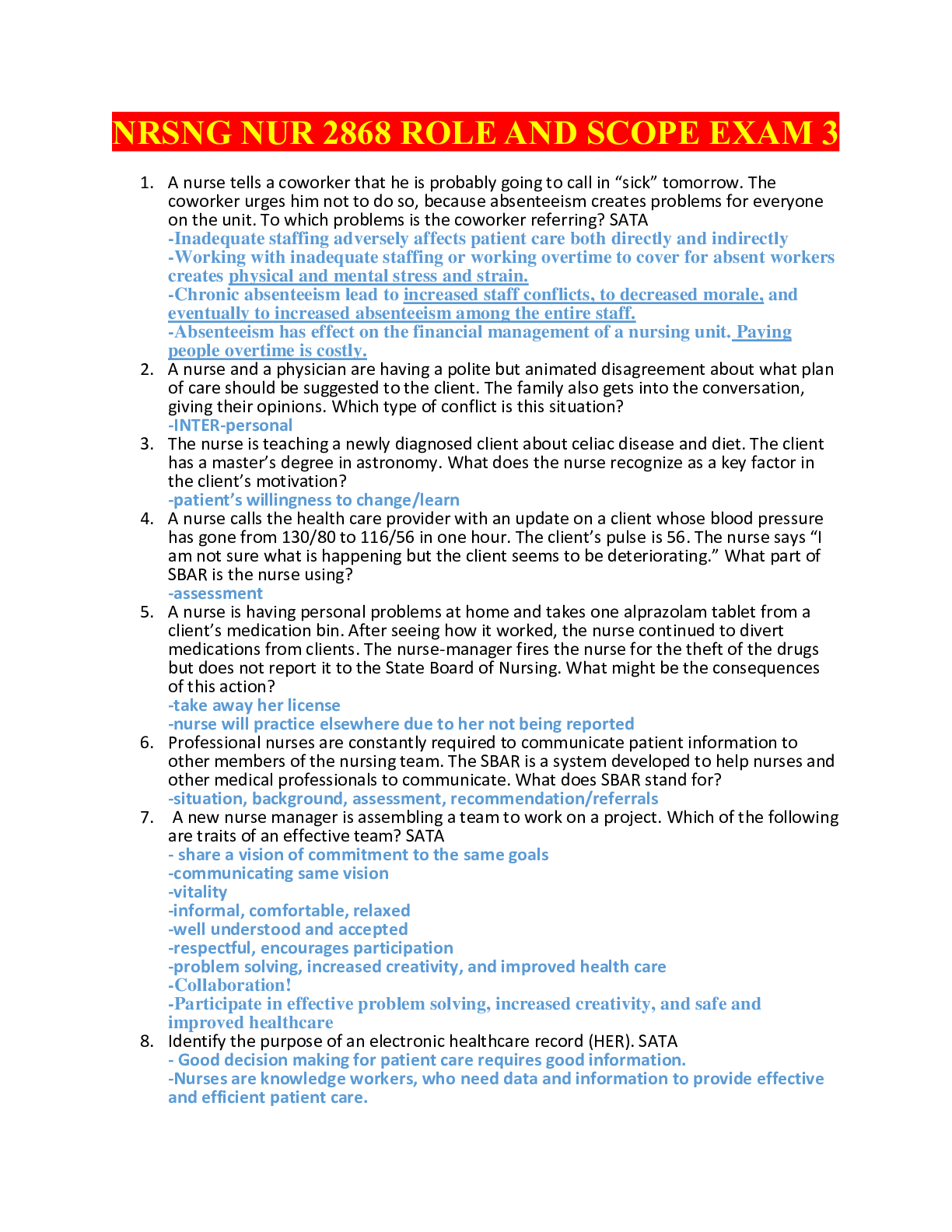

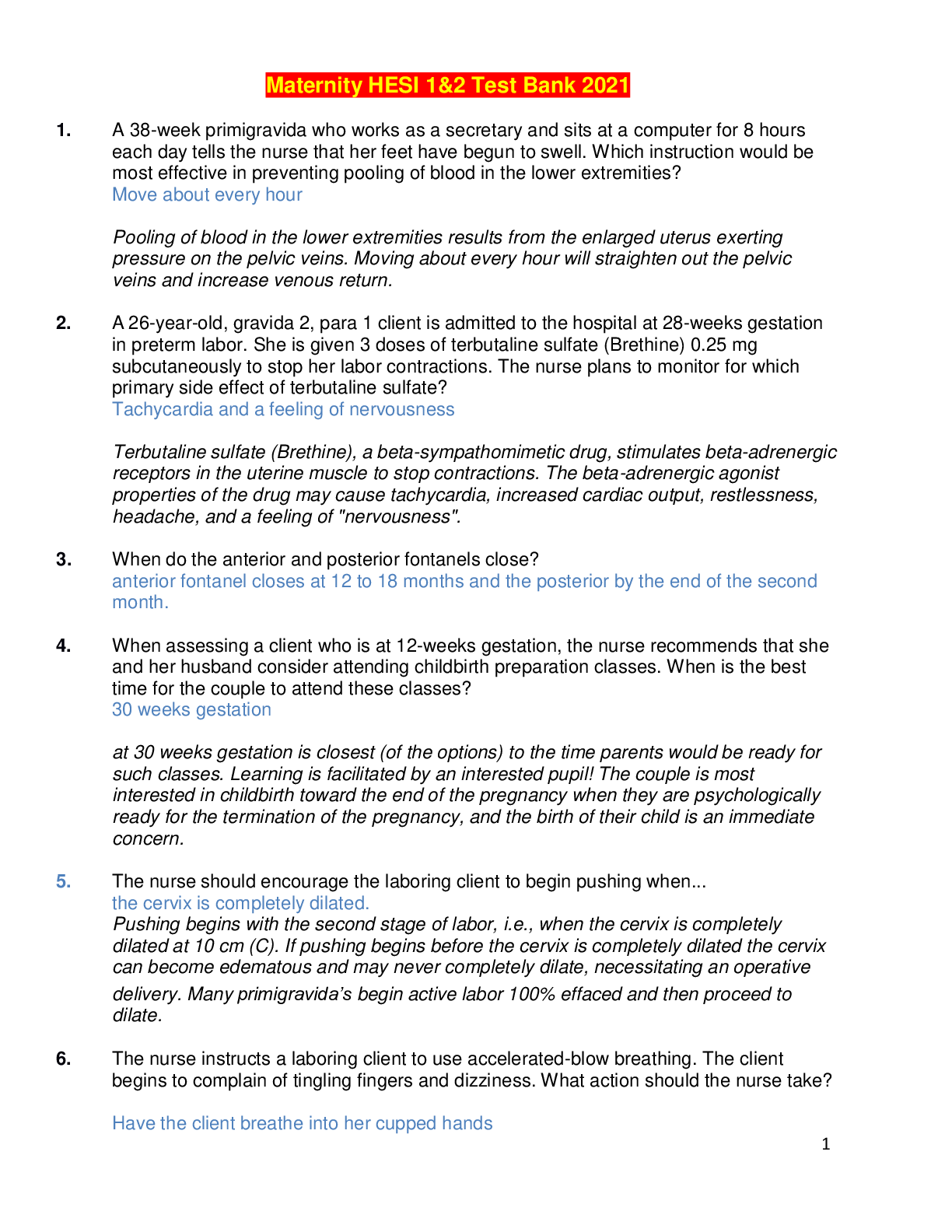
.png)
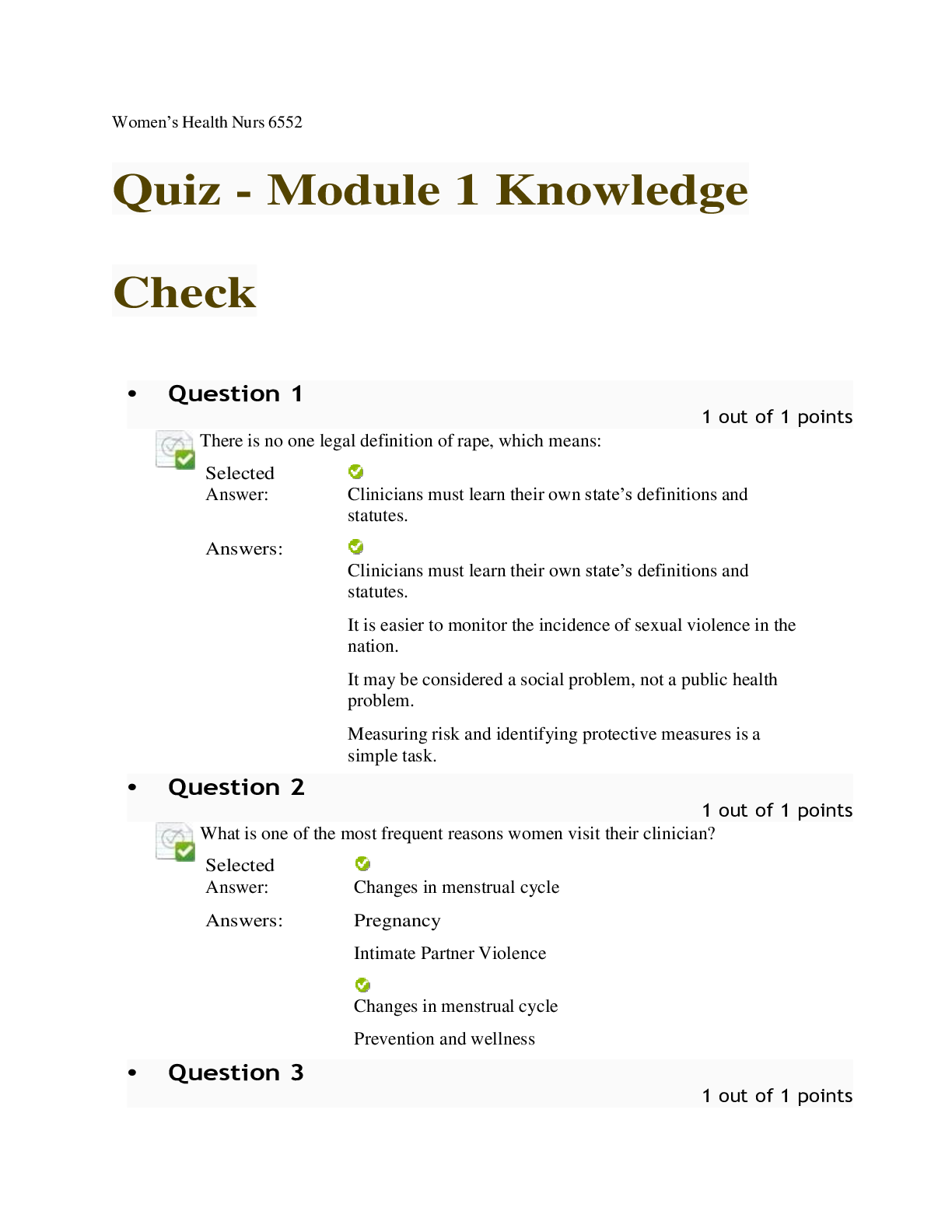
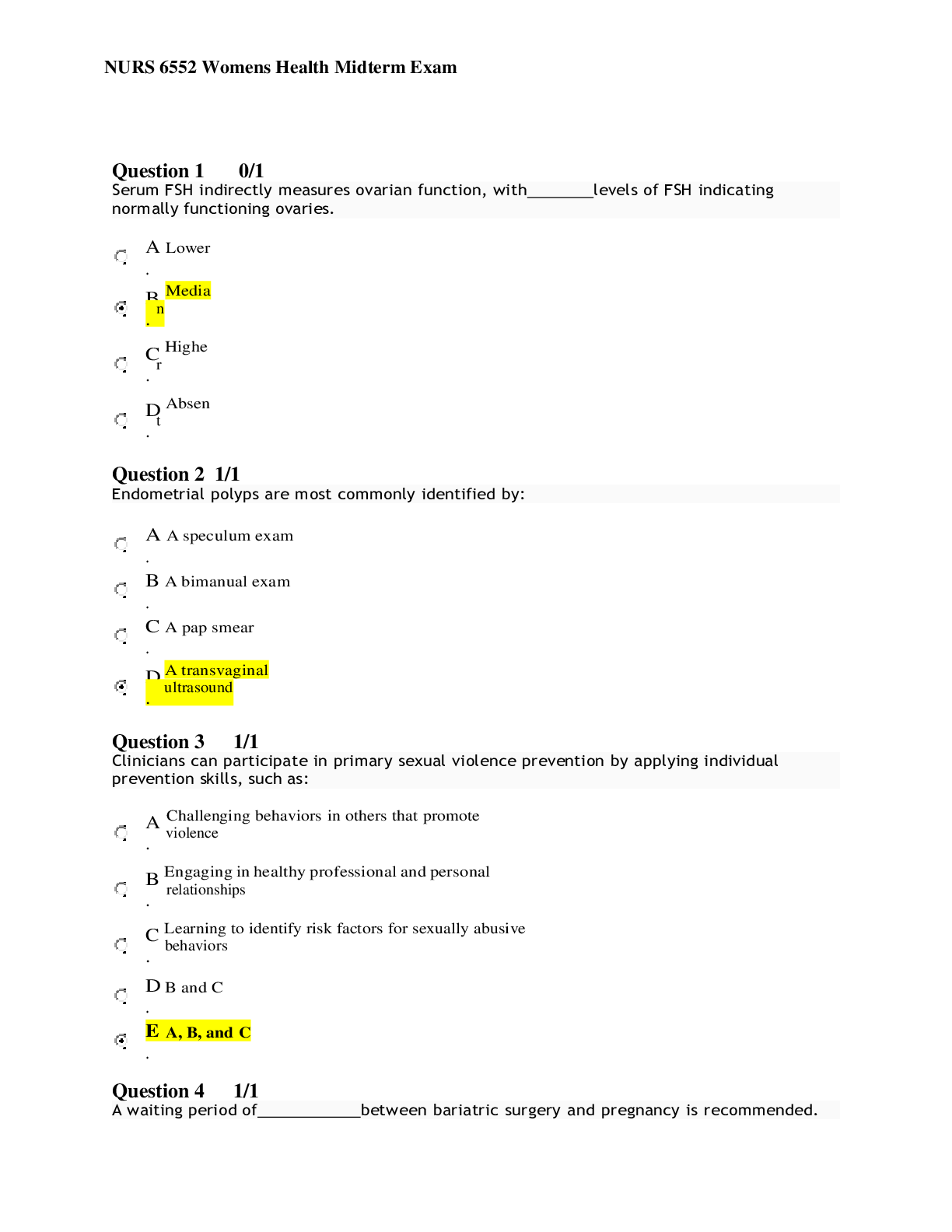


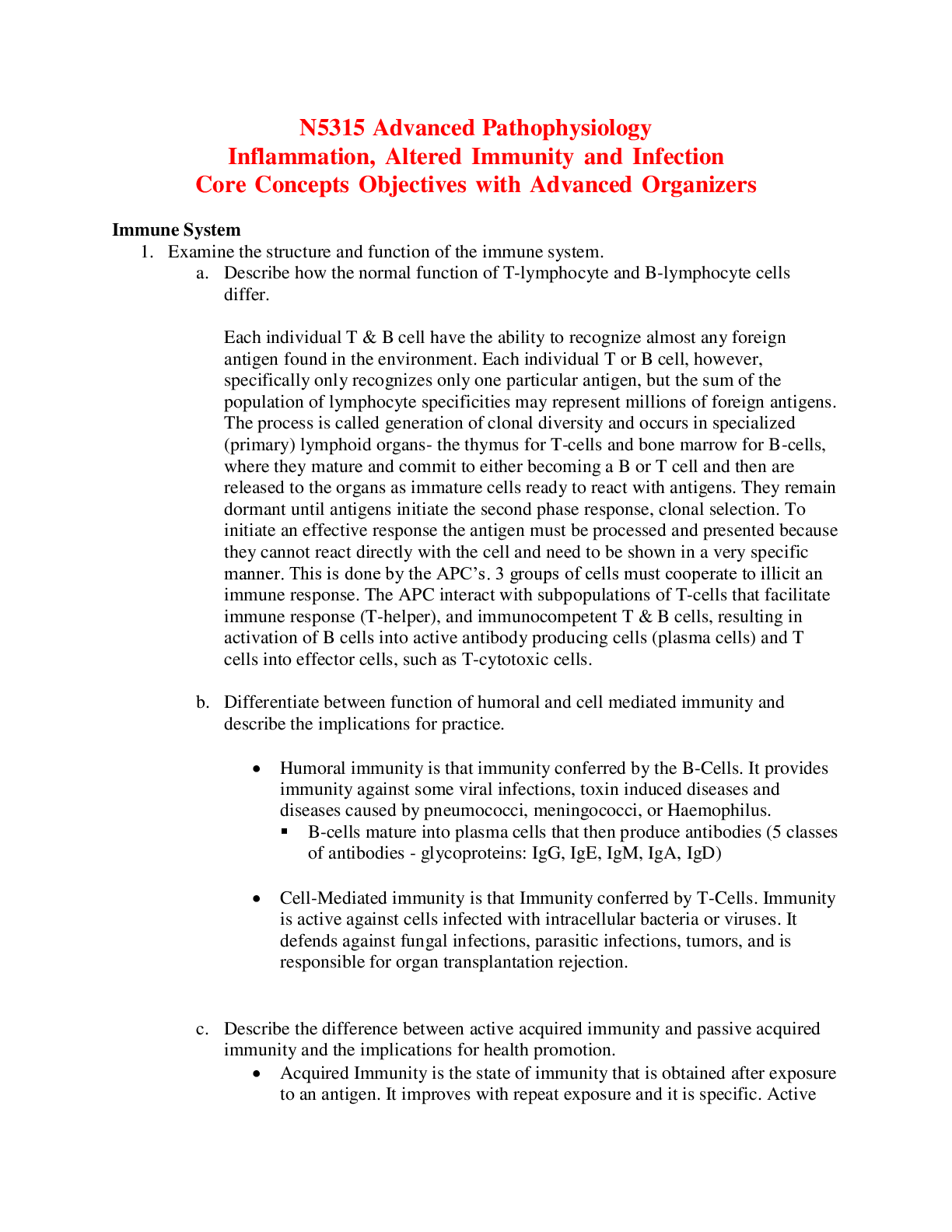

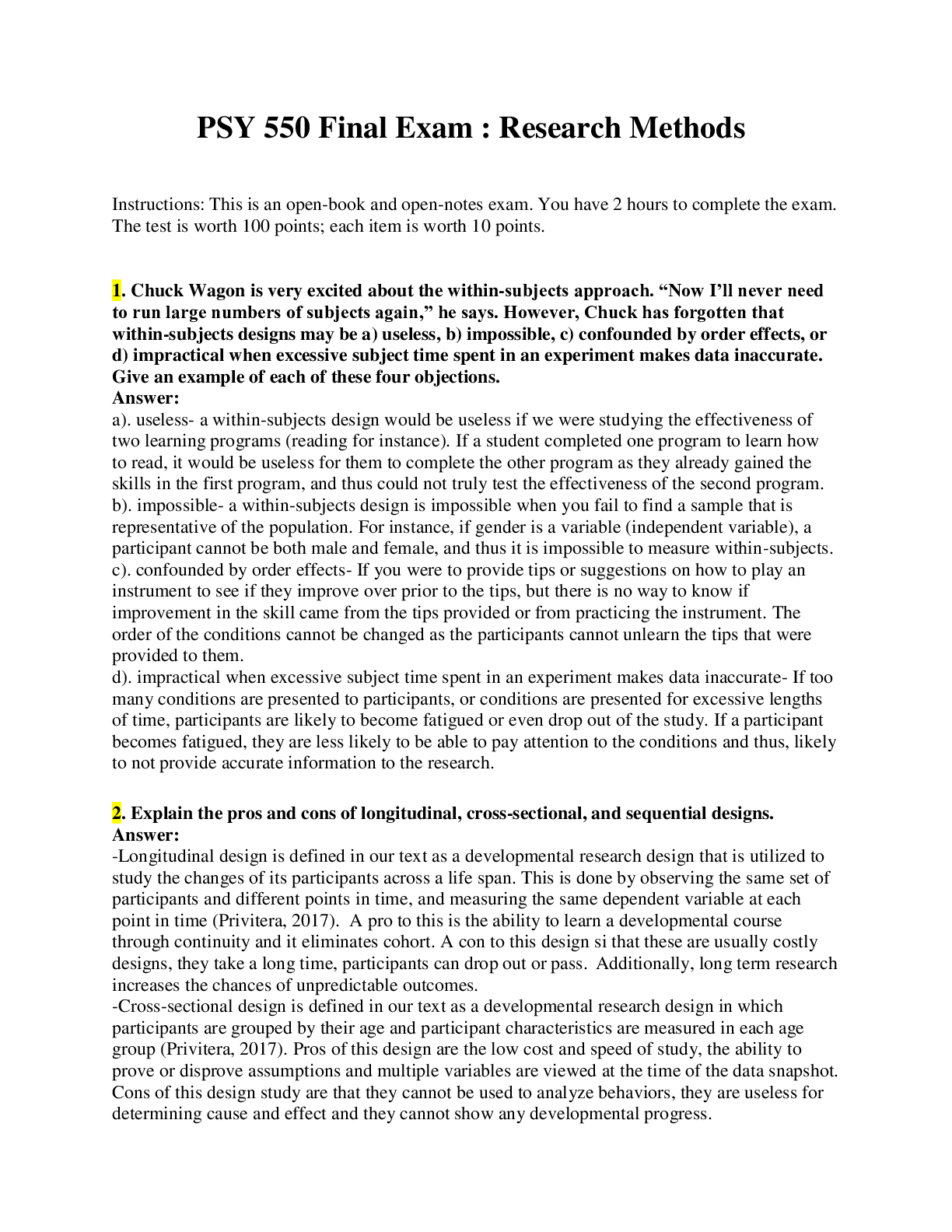




.png)
 by Ricci, Kyle and Carman.png)
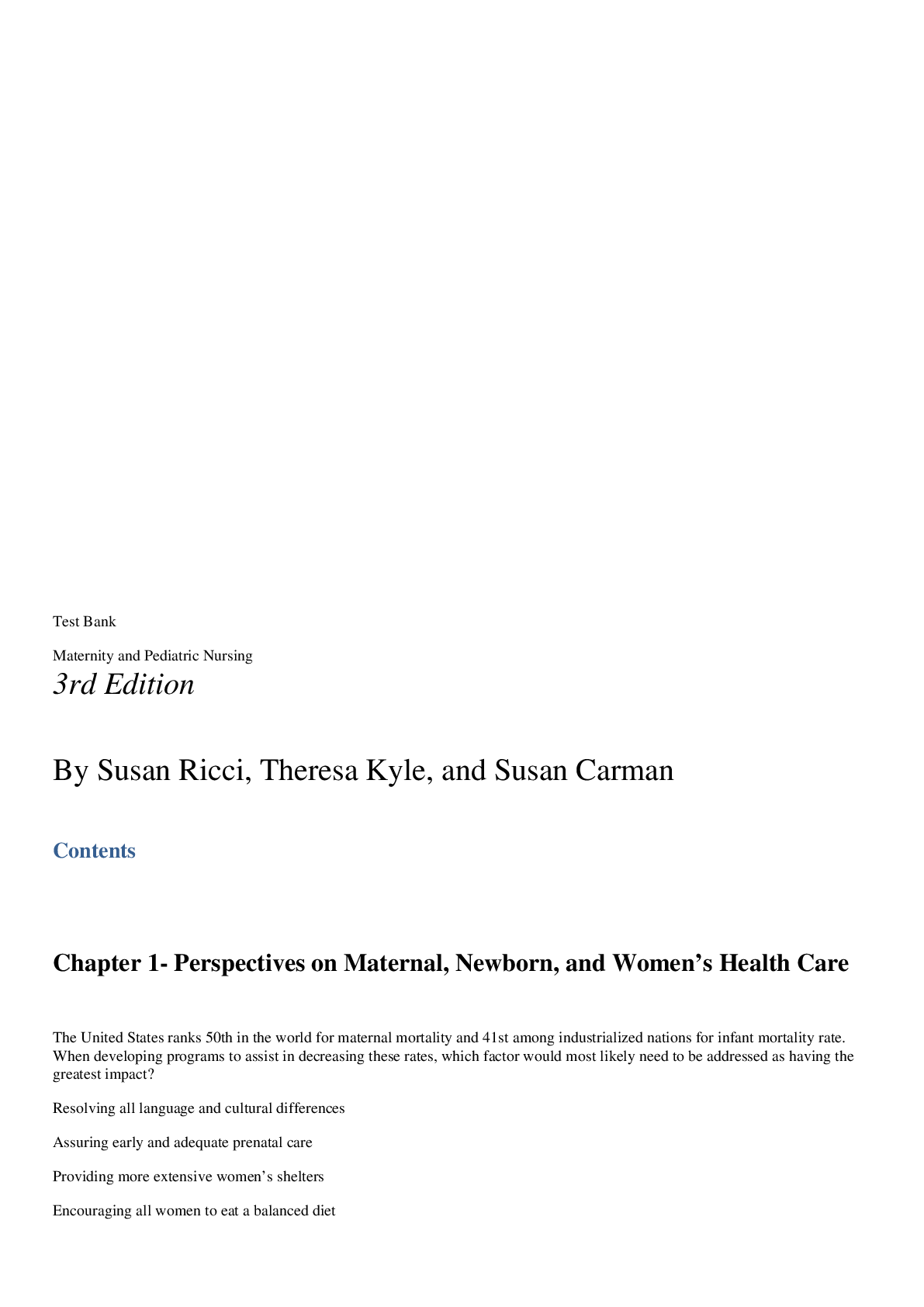
.png)
